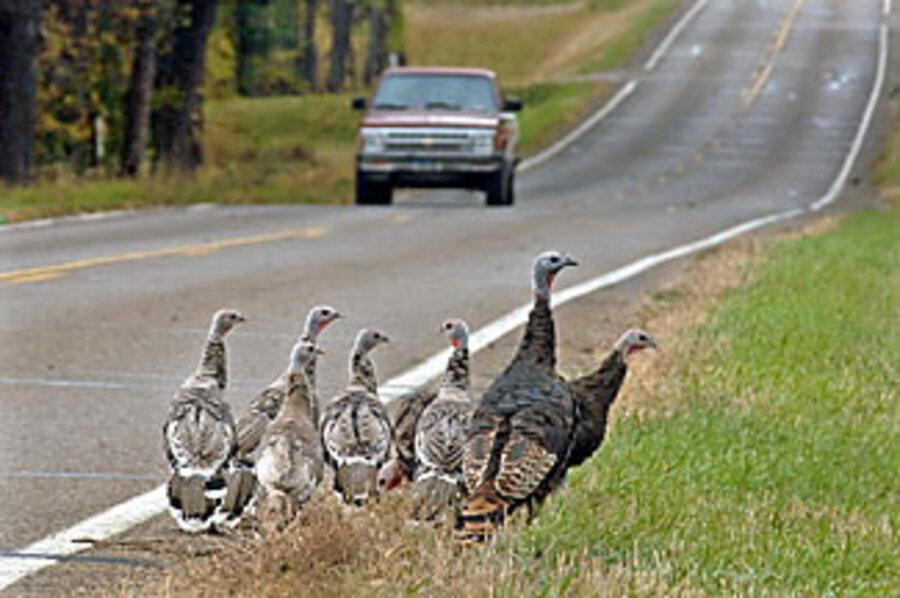In search of wild turkeys
Loading...
Our son thinks we're liars – about the wild turkeys that visit our property and surrounding area, that is. He's never seen them, so he's convinced we're making them up. Nevertheless, my husband and I have seen these creatures in abundance, scavenging for worms and grubs and whatever else may dwell beneath the lush green thatch of our storm-soaked summer lawn, or strutting up the side of our winding country road with ungainly speed and confidence, as if they owned the spongy sod or gravely pavement upon which they strode.
Late last summer, they arrived as usual, pecking and partying from one end of our acreage to the other. There were at least two dozen of them, with four adults chaperoning their adolescent charges, reminiscent of middle school students on a field trip turned loose to explore the delights of their destination. As always, it's a definite challenge for the adults – turkeys, humans, or otherwise – to channel the young ones' joie de vivre into some form of wholesome, instructional activity.
A month later, the youngsters have grown into more worldly-wise high-schoolers, moving briskly and efficiently as they seek repast beneath the fallen leaves covering the still-verdant expanse of our backyard.
When startled, they'll roost in the oaks, maples, and butternuts so plentiful in our area. My husband and I witnessed a dramatic example of this one evening at about dusk, when we visited a nearby ancestral burial ground. Our car pulled up to a whoosh of wings as a dozen or more turkeys took flight and found perches in the burly oaks surrounding the intimate New England cemetery. There they hulked eerily, watching my husband, our two dogs, and me thread our way through the ragged rows of tombstones – stones carved with designs of abstract angels and death's heads appropriate to the 1700s – to pay respects to generations of long-gone relatives. It was a gothic scene that made for a certain unease, as if the birds and souls of the dead had united in their disapproval of our intrusion.
When faced with a flock of fowl, one might assume that our pets would give chase. But the dogs grow still when my husband or I announce in hushed tones, "wild turkeys." Though they stare intently, they do not become agitated or bark. Perhaps they hear the awe in our voices and respond accordingly.
Tops on our list of turkey encounters occurred one afternoon when, while exploring the lower perimeters of our property, Cody, a mixed-breed with (we've been told) some Gordon setter ancestry, stopped and went perfectly on point – perfect except that his long-haired tail was curled upward in a fringed half-circle, breaking the standard head-to-tail line. Clearly there was significant prey in the underbrush.
Before my husband or I could investigate, Caleb, a golden retriever mix, rousted an adult turkey. It rose in a graceful, picturesque, 45-degree arc worthy of any wildlife movie – the type where a bird is flushed and, in one fluid movement, the hunter brings a gun to the shoulder and fires.
Mercifully, there were no gunshots to mar the beauty of the scene, nor was there any sort of canine pursuit. Instead, we stood together quietly – astounded by all we had just seen – until the dogs, praised as "good dogs" for their prowess, replied with excited moans, wide canine grins, and wildly wagging tails.
Equally spectacular was the situation one late spring morning when, while looking from an upstairs window, I observed a tom in a neighboring field set in a classic, Thanksgiving Day turkey pose. While I watched, the fanned-out feathers shifted slowly, showing to best advantage every angle of this male's display of virility and desirability. A hen, hunkered down nearby, watched Mr. Macho strut back and forth, his throat and wattle a seductive, vibrant red.
This performance was repeated several weeks later, right in the middle of our well-traveled thoroughfare! Oblivious to danger, the tom turned with all the dignity and deliberateness of a sumo wrestler, trying to win the heart of a hen, barely visible from her hiding place safely off-road.
And who can forget the fiasco in the middle of our yard?
Four majestic toms cut some mighty fancy didoes while attempting to seduce two slender hens. Sad to say, the females were more interested in ingesting insects than receiving amorous advances. The men-fowl eventually joined them – tail feathers furled.
Too bad our son never saw this. Too bad he's never seen a single solitary turkey on any of his trips to our home in northeastern Connecticut. I cling to the hope that at least one turkey – maybe even two – will grace our property during his next visit. I'd love him to witness their studious scavenging of our bug-laden lawn as well as their ridiculous head-bobbing when they take off, galloping across our land, the fields beyond, and up our rural road. And those mating rituals are truly a sight to behold!
Besides, I know that, until our son sees these birds with his very own eyes, he will continue to believe our wild turkey sightings are merely figments of our imagination.





